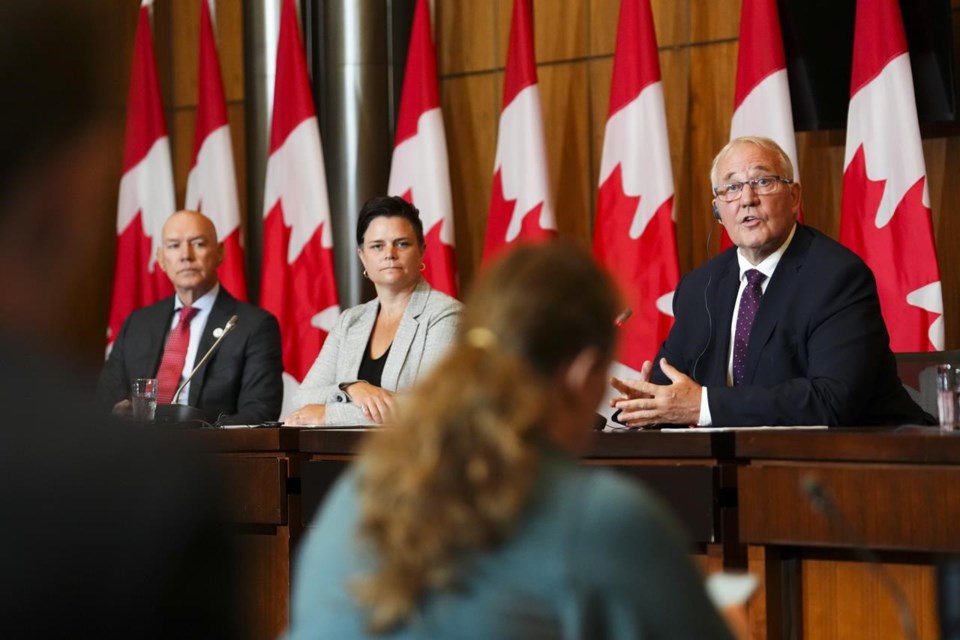OTTAWA — Four Canadian humanitarian aid groups are to use millions of dollars in new funding from the federal government to deploy response teams more quickly as climate change increases the demand on their services.
Leaders from the Canadian Red Cross, the Salvation Army, St. John Ambulance and the Search and Rescue Volunteer Association all said Tuesday the types of events they're responding to in the era of climate change are more severe, more complex and far more frequent than ever before.
The four agencies will share $82 million in new federal funding over the next three years to help them recruit and maintain more skilled volunteer emergency responders, as well as buy more equipment and update their management practices.
Canadian Red Cross President Conrad Sauvé said that a decade ago, his agency's work to respond to large-scale disasters and emergencies was mostly overseas.
"Large events in Canada were seen as the exception and occurred infrequently," he said at a news conference in Ottawa.
He said situations like the Manitoba floods in 1997, the ice storm in Eastern Ontario and Quebec in 1998 and the Kelowna wildfire in 2003 were "devastating disasters, but they were also seen as exceptional."
Then things rapidly changed, he said.
"The vast majority of the Canadian Red Cross response efforts are now domestically focused in supporting impacted Canadians," said Sauvé.
"Disasters and emergencies in Canada are increasing in frequency, severity and complexity … and we can no longer treat these events as exceptional."
The funding comes as a top-up to a humanitarian workforce fund Ottawa created in 2021 when the Canadian Red Cross, in particular, was being called on to help with everything from hospital and long-term care staffing to vaccination clinics and quarantine sites.
It also comes as Canada is in the midst of its worst wildfire season on record, with nearly 95,000 square kilometres burned, nearly 10 times the average amount burned by this point in the summer over the last 25 years.
On Tuesday morning, 877 fires were burning across the country, and 527 were classified as being out of control. While Alberta was hit hardest in May and Quebec in June, the brunt is now being felt in British Columbia, where more than 322 fires are being monitored. Just one week ago, there were 104 fires in B.C.
Emergency Preparedness Minister Bill Blair said the amount of money was decided upon through conversations with the groups about what they need to do the jobs they're being ask to complete.
"This increased capacity will better support Canadians during and after disasters, helping to build resilience, and they are a key pillar to mitigating the effects of climate change," he said.
"It will also help relieve pressure on other organizations, including the Canadian Armed Forces, we often call upon to help during emergencies."
It's also, he said, part of Canada's ongoing discussion about how to better respond to the growth in domestic natural disasters.
Blair is part of cabinet-level discussions about creating a new national disaster response agency that could be similar to the Federal Emergency Management Agency in the United States or the Federal Agency for Technical Relief in Germany.
The military has been called on to help dozens of times in the last decade as floods, fires and hurricanes destroyed homes and businesses in every corner of the country. The demand on the military has increased, and its leaders have warned that its resources are stretched thin.
Canada's disaster statistics show that until the 1960s, there were about 30 weather-related disasters every decade. Now it's more than 100.
Between 2015 and 2019, provinces asked the federal government for help to respond to a weather event a total of five times. In 2020 and 2021, such requests were made 14 times.
This report by The Canadian Press was first published July 11, 2023.
Mia Rabson, The Canadian Press



